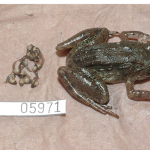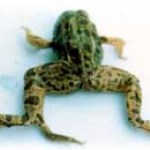Frog
Dr. Clara do Amaral is a postdoctoral fellow at the University of Dayton in Ohio where she studies freeze tolerance in frogs. She received a Research Recognition Award from the Comparative and Evolutionary Physiology section of the American Physiological Society at the 2017 Experimental Biology meeting in Chicago, IL. She prepared this award-winning guest blog entry to describe her interesting research:
The Cope’s gray treefrog is a small frog that occurs in the eastern United States. You can find it sitting on the trunks and branches of trees, and you can hear it calling from the…
via GIPHY
A new article published in the Proceedings of the National Academy of Sciences presents the discovery of a species of frog with fluorescence. The South American polka dot tree frog, aka Hypsiboas punctatus is already rather cute under normal light. But when exposed to UV light, this frog really shines. It gets its glowing personality from fluorescent molecules, hyloin-L1, L2 and G1, found in the skin, lymph tissues, and secretions from glands. These molecules have not been found in other animals. Researchers are not yet sure why these…
Check out the tiny new species of frogs discovered in the cloud forests of Brazil.
Brachycephalus mariaeterezae
Brachycephalus fuscolineatus
Brachycephalus verrucosus
Brachycephalus leopardus
Brachycephalus boticario
Brachycephalus olivaceus
Images from LiveScience.
Yesterday (Tuesday) was another great day for Comparative Physiology!
Congratulations to Dr. Arthur DeVries (above; Professor Emeritus, Department of Molecular and Integrative Physiology; Professor of Animal Biology, University of Illinois), this year's recipient of the August Krogh Distinguished lecturer award from the Comparative and Evolutionary Physiology section of the American Physiological Society. Dr. DeVries gave an excellent seminar summarizing his career studying fish that live in some of the coldest waters without freezing! The fish accomplish this amazing task by having anti-…
Male (left) and female L. Larvaepartus frogs discovered in Sulawesi, Indonesia. Image from Figure 2 of PLOS ONE article.
A new species of frog (Limnonectes larvaepartus) has been discovered in the rain forest of Sulawesi island in Indonesia. This species challenges the grade-school wisdom that taught us: 'frogs lay eggs'. It looks like textbooks will need to be revised as this is the only known exception to that rule. Study author Dr. Jimmy McGuire (University of California, Berkeley) said the following as quoted in Reuters, "Reproduction in most frogs could not be more…
Researchers in Peru have discovered four new species of tiny so-called "glass frogs" (family: Centrolenidae).
Centrolene charapita: with the yellow splotches on its back, this species was aptly named after little yellow chili peppers. Their hindlegs also had fleshy little zigzag-like protuberances whose purpose is unknown.
Figure 4 from Twomey et al. Zootaxa, 2014.
Cochranella guayasamini: This species is mostly green with yellow encircling its eyes. Interestingly, the tadpoles begin as a reddish pink color. Since they live in streambeds that are low in oxygen, this coloration…
Scientists in the jungles of southern India have discovered 14 new species of "dancing frogs" many of which are unfortunately already endangered. DNA analyses have shown that these new species are members of an ancient genus that has been around since the time of the dinosaurs, Micrixalus. There are now 24 known species of dancing frogs. Considering that males outnumber females 100 to 1, these acrobatics are important to attract mates. The tiny frogs are only about the size of a walnut.
Check out this neat video highlighting how frog-eating bats are using frog mating calls to know where to pick up dinner:
Frog with an extra foot. Image from the Minnesota Pollution Control Agency.
Image of a frog with a missing leg from the Minnesota Pollution Control Agency.
Since 1995 deformed frogs have been turning up. Call them the canaries in the coal mine for environmental health. Frogs are showing signs of some kind of stress.
So is it a parasite? Pollution? A natural phenomenon? Cannibalism? Fungus? Ultraviolet light? Something in the water?
Video from YouTube
The tap water data referred to in the video in which they placed embryos in tap water collected from different sites in Minnesota…
The top 10 new species discovered in 2012 has been announced by the International Institute of Species Exploration at Arizona State University.
Tope 10 new species discovered in 2012. Image from: International Institute for Species Exploration, Arizona State University
My favorites:
The adorable tiny frog, Paedophryne amanuensis, from New Guinea that is only 7mm (pictured above on a dime). It is currently considered the smallest living vertebrate.
Glow-in-the-dark cockroaches, Lucihormetica luckae, from Ecuador (top right in composite above). Consider them night lights. Species of…
The Comparative and Evolutionary Physiology section held their Scholander Poster competition for young comparative physiologists today! It was exciting to see all of the students present their work.
Here are some of the highlights:
Raffaele Pilla, Dominic P, D'Agostino, Carol S. Landon, and Jay B. Dean from Molecular Pharmacology and Physiology, University of South Florida, Tampa, FL. These researchers demonstrated that a ketone body, often thought of as waste products resulting from the use of fats for energy, can have protective effects against seizures caused by exposure to…
Left: Derrik Hilton, an asistant in the laboratory of Dr. Charles Ide (right) at Western Michigan University. Image from: Katie Selden / Kalamazoo Gazette
Dr. Charles Ide from Western Michigan University has become a leader in the fight against Multiple symptom atrophy, or MSA, all because of frogs. His research on how contaminants in the Kalamazoo River impacts the health of frogs lead to the discovery that frogs injected with PCBs developed Parkinson's disease like symptoms.
Dr. Ide describes MSA (aka: atypical Parkinson's Disease) as being a trio of disorders making it…
Nearly one-third of the world's amphibian species are at risk of extinction. The rescue project aims to save more than 20 species of frogs in Panama, one of the world's last strongholds for amphibian biodiversity. While the global amphibian crisis is the result of habitat loss, climate change and pollution, chytridiomycosis is likely at least partly responsible for the disappearances of 94 of the 120 frog species thought to have gone extinct since 1980.
Read more about the Panamanian Amphibian Rescue and Conservation Project, and check out their blog, here.
(h/t Smithsonian Institution)
The skeleton of Palaeobatrachus from Lake Enspel, Germany. From Wuttke and Poschmann, 2010.
In On the Origin of Species, Charles Darwin said of the fossil record:
For my part, following out Lyell's metaphor, I look at the natural geological record, as a history of the world imperfectly kept, and written in a changing dialect; of this history we possess the last volume alone, relating only to two or three countries. Of this volume, only here and there a short chapter has been preserved; and of each page, only here and there a few lines. Each word of the slowly-changing language, in which…
Brian says it is draw Muhammad day so here is a nice pic I found:
I'm afraid I don't know the original source - it looks to have been a Frog (this *is* offend everyone day, isn't it?) - oh hold, on, it is Plantu. I've delicately altered the original, I bet you can't tell where :-).
Olde Atrichoke points me to "Jesus and Mo" which has a nice gentle one about excess internet usage, one for the climate-y folk about Denialists. And then there is Today's.
Predictably enough this offends the wackos which I presume is the point - to try to tire them out. Also predictably enough, there is a wiki…
Birth of the Gastric Brooding Frog
Photo Mike Tyler
Unfortunately, species are the ultimate bioephemera.
Amphibians in particular have been declining at an alarming rate over the past several decades; some estimates suggest that a third of amphibian species are on the verge of extinction. My latest essay for SEED's website opens with the story of the Gastric Brooding Frog, Rheobatrachus silus, an extremely peculiar species. It was discovered in the 1970s, and already believed extinct just over a decade later. That's barely enough time to describe a species, much less save it.
Save the Frogs…
This video, which I flat out stole from the unparalleled A Blog Around the Clock, is fascinating.
This reminds me of sonograms of my baby brother.
Did I mention that I got this video from A Blog Around the Clock, A Blog Around the Clock, A Blog Around the Clock, A Blog Around the Clock, A Blog Around the Clock,?
A quick wrap-up of the animals discovered not to be extinct this week:
Armoured mistfrog
This Armoured Mistfrog, thought by many experts to be extinct due to the recent amphibian chytrid fungus epidemic, was rediscovered by my boss, enterprise search god, Chris Cleveland, while he should have been working, on CNN. And more specifically, in a remote tropical area in northern Australia.
Tadpole Shrimp
Heavy rains in Scotland have created perfect conditions for the reemergence of the tadpole shrimp, thought extinct in the UK until recently. The little critter resembles a tiny horseshoe crab…
Discovery.com recently reported two instances of animals manipulating sound to master their environments.
Cuckoos are known for tricking birds into rearing their chicks: They lay their eggs in another species' nest and, once hatched, the baby cuckoos push out the eggs and/or chicks of the host birds. While it's also known that the baby cuckoos can mimic the cries of the host birds' chicks, scientists were surprised to find that one Australian species, the Horsfield's bronze-cuckoo, takes this a step further.
Tengo pince hambre! Je suis baiser affamé! Sono scopare affamato! Excuse me, can…
A study of rare African frogs has revealed a form of self-defense hitherto unbeknownst to the scientific world: claws of pure bone that burst through the frogs' skin. And it gets worse. When the frogs are threatened they need to first "actively break" their own bones in order to create these claws.
Don't make me angry...you wouldn't like me when I'm angry.
David Blackburn of Harvard's Museum of Comparative Zoology released his team's findings last week in Biology Letters on the Trichobatrachus robustus, and ten other related species of frog, most of which live in Cameroon.
The frogs'…






